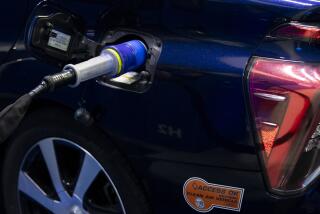Plug-in hybrid cars, hydrogen fuel cells
- Share via
Re “From 0 to 60 in 40 watts,” editorial, April 29
Finally, plug-in hybrid technology is getting the attention it deserves. As a former GM employee on the EV1 electric vehicle program, we proved that the best way to get people to use less oil is to give them the opportunity to use none -- without compromise in performance, safety and convenience. The public embraced that concept more easily than the automakers, and we were collectively gutted when GM abandoned its EV programs.
It has been difficult to get the large automakers to embrace plug-in hybrids because of an intangible conflict: To produce and market a car that is clean and quiet, you inherently imply that your core products -- larger cars, trucks and sport utility vehicles -- are none of those things.
Many automakers are learning that in order to succeed, they must build vehicles that people want to buy. What that means for the public is that there is no better time to ask for what we want. Until we do refuse to settle for less, plug-in hybrids will remain “the technology of the future.”
CHELSEA SEXTON
Executive Director, Plug In America
El Segundo
*
Although you may be right that plug-in hybrids are the best immediate solution to our gas-guzzling problems, I was appalled that your editorial perpetuated the myth that hydrogen is unsafe. Even a cursory review of modern research on the issue reveals that it was not the flammability of hydrogen that caused the Hindenburg disaster; it was caused by the highly flammable fabric covering the dirigible. Hydrogen is no more dangerous than gasoline as a fuel. Safety should not be used as an argument against hydrogen fuel cells.
CURTIS HORTON
Pasadena






